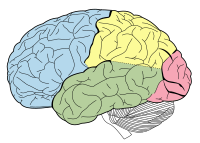
Photo from wikipedia
BACKGROUND Deep brain stimulation (DBS) of the subthalamic nucleus (STN) is a proven and effective therapy for the management of the motor symptoms of Parkinson's disease (PD). While accurate positioning… Click to show full abstract
BACKGROUND Deep brain stimulation (DBS) of the subthalamic nucleus (STN) is a proven and effective therapy for the management of the motor symptoms of Parkinson's disease (PD). While accurate positioning of the stimulating electrode is critical for success of this therapy, precise identification of the STN based on imaging can be challenging. We developed a method to accurately visualize the STN on a standard clinical magnetic resonance imaging (MRI). The method incorporates a database of 7-Tesla (T) MRIs of PD patients together with machine-learning methods (hereafter 7 T-ML). OBJECTIVE To validate the clinical application accuracy of the 7 T-ML method by comparing it with identification of the STN based on intraoperative microelectrode recordings. METHODS Sixteen PD patients who underwent microelectrode-recordings guided STN DBS were included in this study (30 implanted leads and electrode trajectories). The length of the STN along the electrode trajectory and the position of its contacts to dorsal, inside, or ventral to the STN were compared using microelectrode-recordings and the 7 T-ML method computed based on the patient's clinical 3T MRI. RESULTS All 30 electrode trajectories that intersected the STN based on microelectrode-recordings, also intersected it when visualized with the 7 T-ML method. STN trajectory average length was 6.2 ± 0.7 mm based on microelectrode recordings and 5.8 ± 0.9 mm for the 7 T-ML method. We observed a 93% agreement regarding contact location between the microelectrode-recordings and the 7 T-ML method. CONCLUSION The 7 T-ML method is highly consistent with microelectrode-recordings data. This method provides a reliable and accurate patient-specific prediction for targeting the STN.
Journal Title: Neurosurgery
Year Published: 2019
Link to full text (if available)
Share on Social Media: Sign Up to like & get
recommendations!